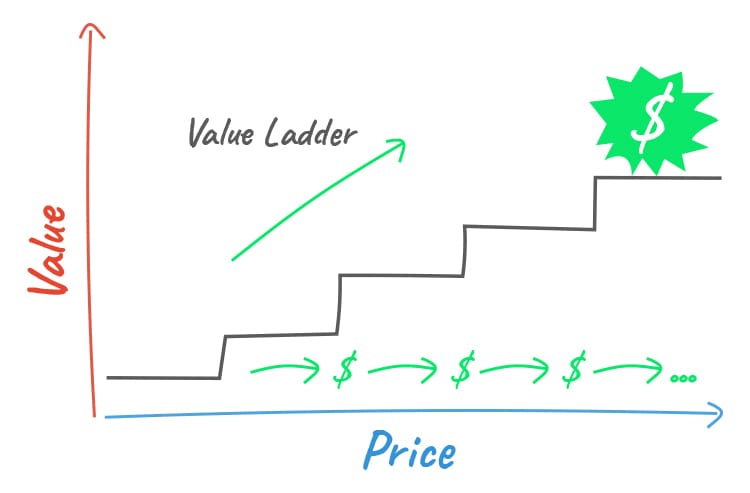Welcome to The Newsletter Operator!
In today’s email:
How to scale your newsletter with horizontal VS vertical growth - and how MorningBrew and The Hustle grew differently
The best thread on newsletter growth I’ve read recently
Sam Parr (founder of The Hustle) launches Hampton
How to get free access to my course
And much more…
Deep Dive
There are 2 ways newsletters scale to tens or hundreds of millions in revenue:
Scaling horizontally
Scaling vertically
Horizontal growth means creating other newsletters and media products that are also monetized through sponsorships. These are other newsletters or media products that serve a different audience or niche.
Vertical growth comes from creating other products to service the same audience or niche. Each new product increases in price and value.
Here are some examples:
Horizontal Growth
MorningBrew started with a daily newsletter and expanded to 8+ newsletters on different topics:
Healthcare Brew
MarketingBrew
RetailBrew
CFO Brew
Tech Brew
HR Brew
IT Brew
& more
Industry Dive has 31 publications in 28 different industry verticals:
Construction Dive
Restaurant Dive
Banking Dive
Waste Dive
Legal Dive
CFO Dive
CIO Dive
& more
Other newsletters like TLDR, The Daily Upside, and The Peak have also started to grow horizontally by launching other newsletters and podcasts.
Horizontal scaling is basically “copying & pasting” the same business model into different niches and topics.
Here are the Pros of scaling horizontally:
Keep focusing on what you’re good at (write, grow, sell)
More ad slots to sell (and more opportunities to cross-sell advertisers)
LTV goes up when subscribers join multiple newsletters and/or podcasts
Here are the Cons:
Revenue isn't diversified - Most or all of your revenue comes from advertisers. If you lose those advertisers or if changes in the economy create an advertising slowdown, your revenue is highly affected.
No recurring revenue - Sponsorships still need to be sold one at a time or in packages.
Misalignment - Your real customers are advertisers, not subscribers
Vertical Growth
The Hustle
Before The Hustle was acquired by HubSpot, it was scaling vertically.
Here’s a breakdown of their product offerings at the time:
The Hustle - free daily newsletter monetized with sponsorships
Trends - $299 per year paid newsletter and community
HustleCon - In-person event. Tickets sold for ~$1000-$2500
Guides - $2000 online courses on topics like newsletters, ecom, and SaaS (these were in progress but never released)
The Newsette
The Newsette has a daily newsletter with over 500,000 subscribers, monetized with sponsorships.
They also have an agency called Newland that works with past newsletter advertisers and offers more marketing services.
Newland now accounts for >50% of their revenue.
In this case, instead of offering their subscribers more value - they provided more value and earned more money from their customers (Newsette’s advertisers).
Ben’s Bites
Ben’s Bites is an AI newsletter with 60,000+ subscribers.
Ben has an AI job board, community, founder & investor connect, and maker-in-residence program. All of these offers are free now, but they can be monetized in the future.
Growing Vertical and Horizontal
WorkWeek is the only newsletter I’ve seen do both.
They have 20+ newsletters across different niches like HR, Healthcare, marketing, fintech, sales, media, and more.
These are primarily monetized with sponsorships.
However, WorkWeek also makes money through lead generation, recruiting services, events, ghostwriting services, and paid communities.
My Thoughts
I think startups that follow the “MorningBrew for X” model will have the most success by scaling vertically.
Media is hyper-competitive, so for most, it’s best to pick one niche they can be the best in the world at, then help that niche in as many ways as they can.
Your Value Ladder
In a previous newsletter, I talked about the concept of a “value ladder”. Media startups should create a ladder to grow vertically and better serve and monetize their audience.

On each step of the value ladder is one of your offers — and those offers increase in value and cost as customers go up from left to right.
Here are the most common product offers media companies and creators use to build their ladders:
Paid newsletter
Paid community
Job Board
Online Course
SaaS
Physical products
Coaching Program
Mastermind
Agency
Productized service
Events
Investment fund
Next week, I’ll cover 10+ examples of how newsletters, creators, and media companies launched these products and the pros and cons of each product type.
The Best Links
📈 Growth
How Justin Moore added 11,134 subscribers in the last 82 days (link)
The formula you should use to calculate newsletter churn rate (link)
💰 Monetization
Why YouTubers Should Have Newsletters (link)
WorkWeek launches a paid community membership (link)
Newsletter publishers see uptick in revenue despite advertising slowdown (link)
How to use the Inverted Pyramid to increase the CTR of your newsletter ads (link)
👀 ICYMI
Substack raised $5M via crowdfunding at a $585 million valuation. Here are my thoughts (link)
📰 Newsletter News
Sam Parr (founder of The Hustle) publicly launches Hampton – a vetted community for founders and CEOs. (link)
This interview with Sam Parr on how he grew Hampton is super insightful. If you want to build a community check this out. (link)
Beehiiv released some handy new features including a WordPress plugin, segmentation updates, global UTM parameters, and more (link)
BEFORE YOU GO
Get my free guide on how to grow your newsletter to 1,000+ subscribers in 30 days
Sign up to get instant access to the guide. Plus, more growth tactics, case studies, and industry news delivered to your inbox.
Join 60,000+ readers for free.
